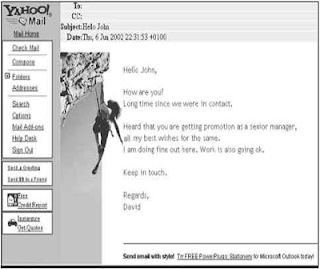A. Look at the pictures and say what you see in them.
B. Work in pairs. Discuss which of the following words you are familiar with. How are they related to e-communication?
facebook, e-mail, web site, blog, e-commerce, twitter, e-learning, iPod, tablet pc, information super high way, social network, smart phone
C. Read the text and answer the questions that follow.
Let's imagine a citizen's ordinary day at work. The morning probably starts with a cup of coffee/tea, followed by greeting the colleagues. Then comes the inevitable, which is logging in the computer. For many of us the third step has become an automatic behavior and it dominates the rest of our work day, receiving and sending dozens of emails.
An e-mail is an electronic mail. It is a computer-aided way of exchanging digital text messages from a sender to one or multiple recipient/s. E-mails operate through a network of computers linked by the Internet. There are commercial server agencies such as Yahoo, Gmail, Ymail, Hotmail, etc. that accept the text message from the sender, forward it and deliver instantly to the digital mailbox of the recipient.
If the recipient is not online, the message is stored and delivered later when the recipient is online. It works instantly just with the click of your mouse. It has been a powerful communication tool in modern life.
Questions
1 What is an e-mail?
2 How do e-mails operate?
3 How do the commercial servers serve in the process of an e-mail?
4 It has been a powerful communication tool in modern life.' Explain the statement.
5 How do e-mails affect our daily work schedule?
D. Work in pairs and discuss the steps of your normal days, weekends, etc.
E. Pairwork. Read the following e-mail exchanged between two friends. Like an informal letter, an e-mail to a close one is casually written. Identify the mistakes in the main body of the message, discuss with your partner, and correct them.
Subject: Details of Dhaka Tour
FROM : Alexa Dowson<alexa.dowson@yahoo.com>
TO : Moutushi Laboni<moutushi1997@ymail.com>
Monday, 21 May 2020 6:20 AM
Hi Moutushi!
Thanks for your mail. I'll fly from Ottawa on 7:36 hours local time on 13 July with Qatar Airlines via London-Doha and land Dhaka on 15 July around 13:41 hours local time. Wish to stay 2 days in the Cox's Bazar and 1 day in Khulna. Return flight on 21 July at 3:04 hours local time.
Keep fine and in touch. Hope to see you soon!
Alexa
F. Pairwork. The e-mail in section E is a reply by Alexa to Moutushi's previous e-mail. Imagine what Moutushi might have written to Alexa. Write that e-mail.
G. Read the following text. It gives the information about the origin of the e-mail. Choose the appropriate forms of the verbs from the box to complete the sentences. You can use a verb more than once.
send say use remain call expand allow develop spread
Sending text messages electronically could be.......... to date back to the Morse code telegraph of the mid 1800s and the 1939 New York World's Fair. In the fair, IBM.......... a letter of congratulations from San Francisco to New York on an IBM radio-type,.......... it a high-speed substitute for mail service in the world of tomorrow. Teleprinters were.......... in Germany during World War II. The use.......... until the late 1960s when there was a worldwide Telex network. Additionally, there was the
similar American system.......... TWX which.......... important until the late 1980s.
With the introduction of MIT's Compatible Time-Sharing System (CTSS) in 1961, for the first time multiple users were.......... to log into a central system from remote dial-up terminals. They were also able to store and share files on the central disk. Informal methods of using this to pass messages.......... and were.......... to create the first true e-mail system.
H. Read the following grid first. Then listen to the Audio and tick the right box in the following grid.
Listening text 10
Comparison among e-mails, phone conversations and face to face meetings
time-consuming
|
reliable
|
efficient
|
||||
less
|
more
|
less
|
more
|
less
|
more
|
|
E-mails
|
||||||
Phone conversations
|
||||||
F to F
meetings
|
||||||
I. Group work. Arrange a debate in the class on the advantages and the disadvantages of the e-mail.
If you want to read the next lesson of this unit please click the link below:







0 Comments:
Post a Comment